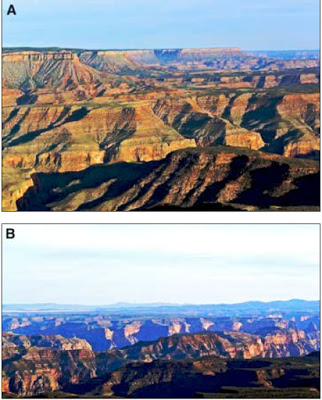
The age of the Grand Canyon (USA) has been studied for years, with recent technological advances facilitating new attempts to determine when erosion of this iconic canyon began. The result is sometimes conflicting ages based on different types of data; most data support the notion that the canyon began to erode to its current form about six million years ago. Then even newer, “high-tech,” data became available and questions were again raised about whether the western end of the canyon could be older.
Two numbers are used as general time markers for these alternate hypotheses. The first suggests that the canyon may have started incising 17 million years ago. The second suggests that the canyon may have looked largely as it does today 70 million years ago. The time contrast between these hypotheses is striking, and any accurate concept of the canyon would have to be consistent with all observations.
Other researchers have studied the Grand Wash Fault, which truncates the western Grand Canyon. The fault runs north to south, nearly perpendicular to the Canyon. The fault slides in such a way that the west side of the fracture moves down relative to the east side, leaving a cliff face called the Grand Wash Cliffs. This slip, called “normal slip,” has led to the opening of a valley called the Grand Wash trough along the east end of Lake Meade. Erosion of hillslopes and canyons in the Grand Wash Cliffs is driven by the fault movement exposing the rock at the surface. These hillslopes and canyons are similar to the Colorado River’s tributaries in Grand Canyon, except hills and side streams are all steeper in Grand Canyon.
This comparison is useful because the Grand Wash fault has been studied extensively, and other scientists have shown that the fault completed most of its sliding between 18 and 12 million years ago. The rocks and climate in both regions are similar, so the difference in landform shape is most likely due to when the landforms started eroding.
In this new article for Geosphere, Andrew Darling and Kelin Whipple focus on the western Grand Canyon, west of the Hurricane fault. Their data show that the Grand Canyon must be younger than the fault slip that occurred 18 to 12 million years ago. Comparing their data to other datasets suggests that the notion that the canyon starting eroding around six million years ago is still the best scientific idea for the age of the Grand Canyon.
Reference:
Geomorphic constraints on the age of the western Grand CanyonAndrew Darling and Kelin Whipple, Arizona State University, Tempe, Arizona, USA. Published online on 10 June 2015; DOI: 10.1130/GES01131.1.
Note : The above story is based on materials provided by Geological Society of America.










